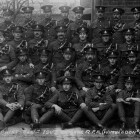Bomb damage in Runnymede, Colliers Wood
| Date Photo Taken | 16th August 1940 |
|---|---|
| Area | Colliers Wood |
| Picture Reference | Mit_War_2-3b |
| Original Format | Photo |
| Notes / History | This picture shows the value of domestic Anderson shelters during the Second World War. The bomb that fell on these houses in Runnymede, Mitcham on 16th August 1940 caused considerable damage. Roofs were seriously damaged, windows were blown out and wrenched off their hinges yet the people in this shelter were unharmed. Anderson Shelters were named after Sir John Anderson who was put in charge of Air Raid Precautions in November 1938.. He immediately commissioned the engineer, William Patterson, to design a small and cheap shelter that could be erected in people's gardens. The first 'Anderson' shelter was erected in a garden in Islington, London on 25 February 1939 and, between then and the outbreak of the war in September, around 1.5 million shelters were distributed to people living in areas expected to be bombed by the Luftwaffe. During the war a further 2.1 million were erected. Made from galvanised corrugated steel, and sunk into the ground, each shelter kit came with detailed instructions. The shelters were held together with bolts and every kit was provided with a spanner-tommy bar. After construction, the spanner was kept in the shelter as it might be needed to loosen the clip bolts at the back of the shelter, and so create an emergency exit if the main door was blocked by bomb debris (andersonshelters.org.uk). It was vitally important that Anderson air raid shelters were correctly installed with a thick layer of earth covering the metal structure. . |









